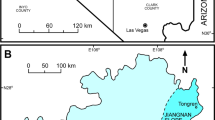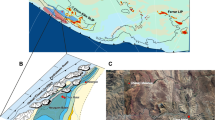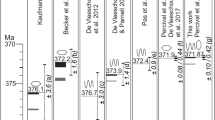Abstract
Early investigators1,2 noticed that the isotope age curve for sedimentary carbon contains a negative displacement in δ13C at the Precambrian/Cambrian (PC/C) boundary, about 570 million years ago3, which may have accompanied the profound biotic changes4 from non-skeletal organisms to those with mineralized skeletons. Whereas the certainty of the δ13C shift across the elusive boundary has recently been confirmed from a number of localities5–8, its interpretation remains largely controversial. It has been attributed to variations in oceanic biomass fertility and concomitant fluxes of organic matter burial6–8, changing rates of ocean ventilation9, onset of biomineralization10 and extraterrestrial causes5. Here we report the results of a carbon isotope study from a hitherto unexplored section of marine sediments in the Lesser Himalaya, India, which documents significant isotope variations across the PC/C boundary. These results also provide important details towards resolving the relative timing of the δ13C shifts and the biotic changes. Evaluation of our data rules out post-depositional isotope exchange as a major cause of the recorded δ13C variations and favours changes in the isotope chemistry of the ocean surface at the close of the Precambrian.
This is a preview of subscription content, access via your institution
Access options
Subscribe to this journal
Receive 51 print issues and online access
$199.00 per year
only $3.90 per issue
Buy this article
- Purchase on Springer Link
- Instant access to full article PDF
Prices may be subject to local taxes which are calculated during checkout
Similar content being viewed by others
References
1. Schidlowski, M., Eichmann, R. & Junge, C. E. Precambrian Res. 2, 1–69 (1975).
2. Veizer, J. & Hoefs, J. Geochim. cosmochim. Acta 40, 1387–1395 (1978).
3. James, H. L. Precambrian Res. 15, 191–198 (1981).
4. Stanley, S. M. Am. J. Sci. 276, 56–76 (1976).
5. Hsu, K. J. et al. Nature 316, 809–811 (1985).
6. Tucker, M. E. Nature 319, 48–50 (1986).
7. Magaritz, M., Holser, W. T. & Kirschvink, J. L. Nature 320, 258–259 (1986).
8. Lambert, I. B., Walter, M. R., Wenlong, Z., Songnian, L. & Guogan, M. Nature 325,140–142 (1987).
9. Goodfellow, W. D. Nature 322, 116–117 (1986).
10. Degens, E. T., Kazmierczak, J. & Ittekkot, V. Tschermaks miner, petrogr. Mitt. 35, 117–126 (1986).
11. Gorin, G. E., Racz, L. G. & Walter, M. R. Am. Ass. Petrol. GeoL Bull. 66,2609–2627 (1982).
12. Banerjee, D. M. Geol. Sum Bull Finl. 331, 73–89 (1985).
13. Singh, I. B. & Rai, V. J. Paleont. Soc. India 28, 67–90 (1983).
14. Rozanov, A. Yu. Episodes 7, 20–24 (1984).
15. Holser, W. T. Nature 267, 403–408 (1977).
16. Cook, P. J. & Shergold, J. H. Nature 308, 231–236 (1984).
17. McCrea, J. M. /. chem. Phys. 18, 849–857 (1950).
18. Banerjee, D. M., Schidlowski, M. & Arneth, J. D. Precambrian Res. 33, 239–253 (1986).
19. Craig, H. Geochim. cosmochim. Acta 12, 133–149 (1957).
20. Clayton, R. M. & Degens, E. T. Am. Ass. Petrol Geol. Bull. 43, 890–897 (1959).
21. Irwin, H., Curtis, C. & Coleman, M. Nature 269, 209–213 (1977).
22. Kolodny, Y. IsraelJ. Earth Sci. 29, 147–156 (1980).
23. Veizer, J. / sedim. Petrol 47, 565–581 (1977).
24. Tucker, M. E. Geology 10, 7–12 (1982).
25. Aharon, P., Kolodny, Y. & Sass, E. /. Geol. 85, 27–48 (1977).
26. Aharon, P., Socki, R. A. & Chan, L. /. Geol 95, 187–203 (1987).
27. Veizer, J., Compston, W., Clauer, N. & Schidlowski, M. Geochim. cosmochim. Acta 47, 295–302 (1983).
28. Fritz, P. Earth planet. Sci. Lett. 11, 277–282 (1971).
29. Hudson, J. D. J. geol. Soc. Lond. 133, 637–660 (1977).
30. Scholle, P. A. & Arthur, M. A. Am. Ass. Petrol Geol Bull 64, 67–87 (1980).
31. Aharon, P. in The Carbon Cycle and Atmospheric CO2: Natural Variations Archean to Present (eds Sudquist, E. T. & Broecker, W. S.) 343–355 (Am. Geophys. Union, Washington DC, 1985).
32. Schidlowski, M., Eichman, R. & Junge, C. E. Geochim. cosmochim. Acta 40,449–455 (1976).
33. Broecker, W. S. Geochim. cosmochim. Acta 46, 1689–1705 (1982).
34. Magaritz, M., Anderson, R. Y., Holser, W. T., Saltzman, E. S. & Garber, J. Earth planet. Sci. Lett. 66, 111–124 (1983).
35. Cowie, J. W. & Rozanov, A. Yu. Geol Mag. 120(2), 129–139 (1983).
Author information
Authors and Affiliations
Rights and permissions
About this article
Cite this article
Aharon, P., Schidlowski, M. & Singh, I. Chronostratigraphic markers in the end-Precambrian carbon isotope record of the Lesser Himalaya. Nature 327, 699–702 (1987). https://doi.org/10.1038/327699a0
Received:
Accepted:
Issue Date:
DOI: https://doi.org/10.1038/327699a0
This article is cited by
-
Redox conditions of Early Cambrian Ocean as deciphered from multi-proxy geochemical and isotopic studies of Proto-Tethys carbonaceous sediments from Outer Lesser Himalaya, India
Journal of Earth System Science (2024)
-
Precambrian and early Cambrian palaeobiology of India: Quo Vadis
Proceedings of the Indian National Science Academy (2021)
-
Early Cambrian trail Archaeonassa from the Sankholi Formation (Tal Group), Nigali Dhar syncline (Sirmur district), Himachal Pradesh
Journal of the Geological Society of India (2015)
-
Significant carbon isotope excursions in the Cambrian and their implications for global correlations
Science China Earth Sciences (2011)
-
Carbon and oxygen isotopic variations in stromatolitic dolomites of Palaeoproterozoic Vempalle Formation, Cuddapah Basin, India
Carbonates and Evaporites (2011)
Comments
By submitting a comment you agree to abide by our Terms and Community Guidelines. If you find something abusive or that does not comply with our terms or guidelines please flag it as inappropriate.



